Prime Day 2019 – All the deals!
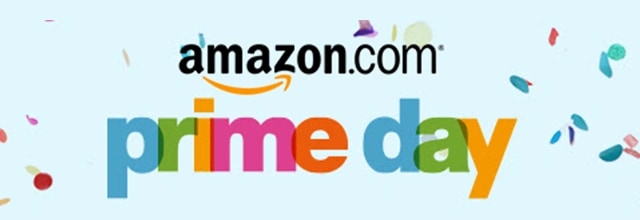
I’m switching things up just a bit. I found a better way to organize all the deals. Please visit the page below to see those deals!

Modern Quilting: Tips, Tricks & Tutorials
Let’s take an in-depth look at sewing tools and notions for the Modern Quilter! These are some of my favorites in my own sewing room.

I’m switching things up just a bit. I found a better way to organize all the deals. Please visit the page below to see those deals!
I didn’t really NEED a new Pin Cushion. What I really wanted was a fun creative DIY project and the satisfaction of turning one cheap thing into a completely different and useful other thing… the result was this DIY Pineapple Pin Cushion from the dollar store!
And know what? I LOVE it turned out! A win-win! I’m sharing a step by step tutorial today so you can make one too!
I’ve seen this saying floating around Pinterest…

…And I really love it, but it feels too cliche to just print it out and frame it for myself. I’ve been looking for a way to add it into my decor somehow as a reminder without being quite so blunt about it.
I created this pincushion that will be a visual reminder of the sweet (pun intended) message whenever I use it!
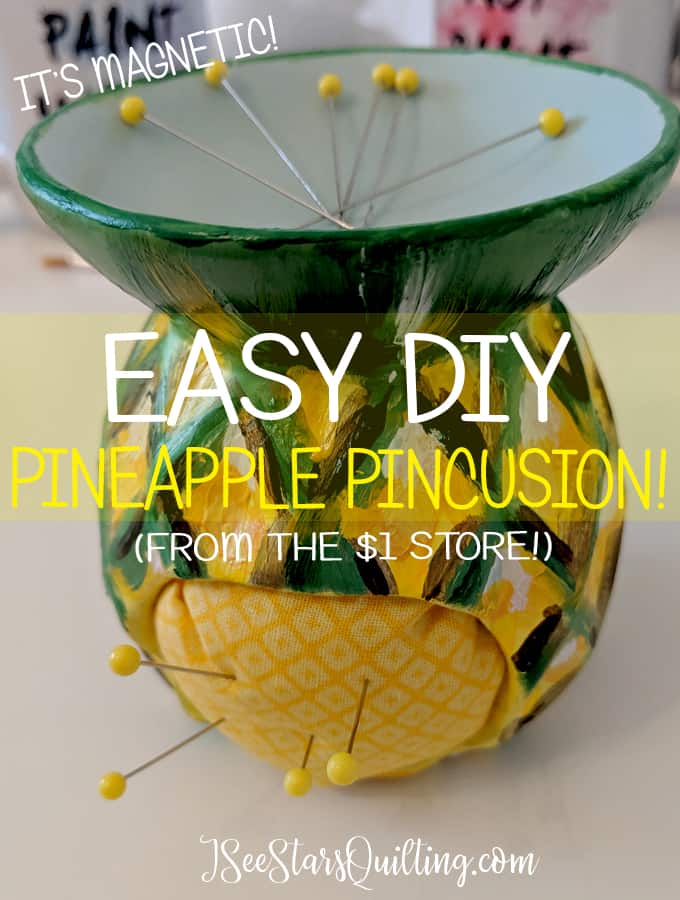
First off… I have a confession. Above is a picture of the finished product. What it started out as, does not look at all like a pincushion or a pineapple.
It takes a bit of imagination to see the whole project though.
In our family, we shop the dollar store a lot. It seems like there is always something we need from there. When you’re on a budget and looking for something to transform, it is a total crafter’s playground!
I looked in the plates and dishes isle but couldn’t find anything worth transforming there. I went over to the arts/crafts/candle aisle and I came across this item:
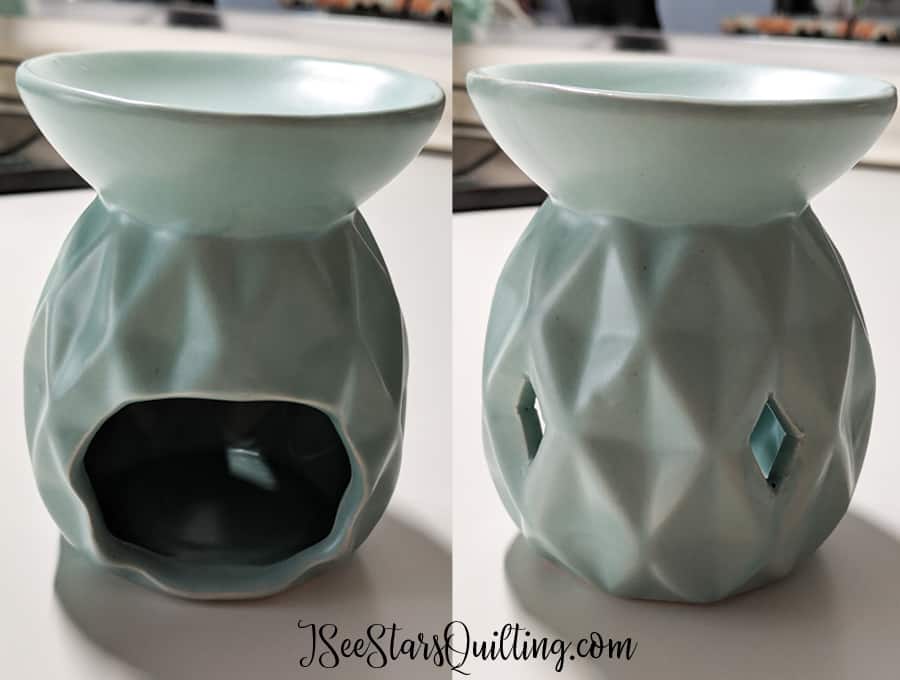
It is a wax melter? I don’t know the official name for it… but you put a little tea light in the open part and a few scented wax cubes at the top. It slowly warms to wax and voila… beautiful smells!
The more I looked at it, the more the patterns on the sides drew me in and I could slowly see my symbolic pineapple piece emerging!
The pineapple was going to happen!
After you have your dollar store treasure, you’ll need just a few more things…
I really wanted a magnetic spot to drop pins. The easiest way to DIY that is to glue your own magnets on the underside of whatever you want to drop your pins in!
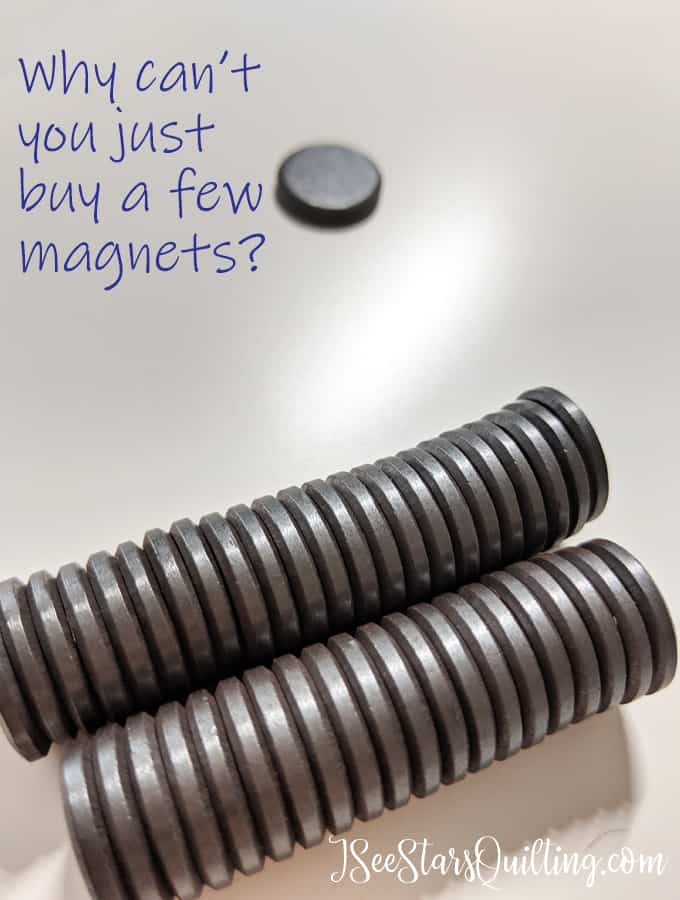
They come in packs of like 50+ so you could easily make a bunch of these for friends or split a pack with a friend.
On every single other occasion (except today!) I recommend this glue. It is amazing! It is my favorite. If you don’t have a go-to craft glue, I highly suggest this one.
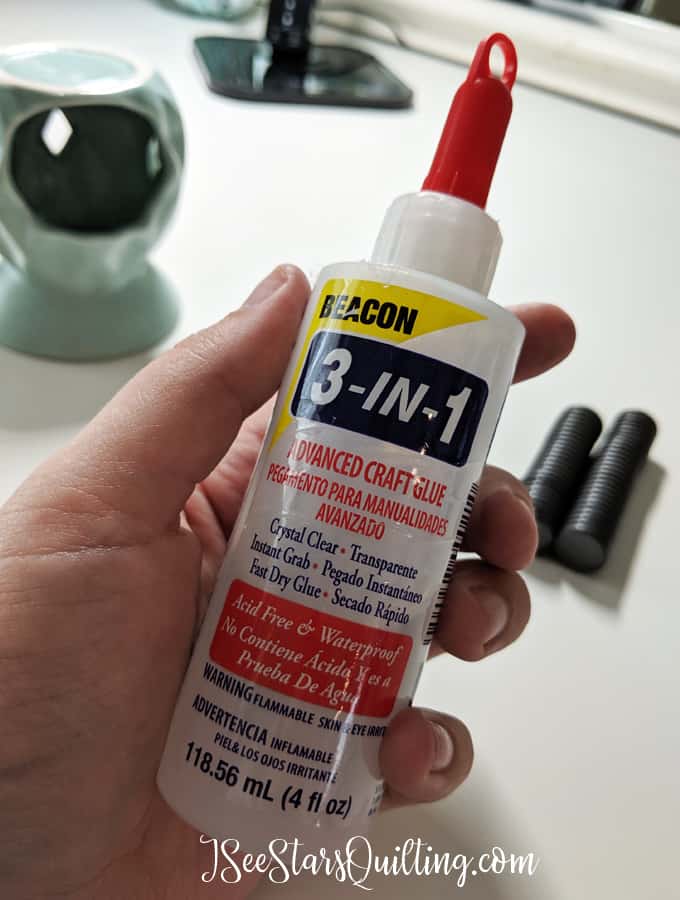
BUT again… NOT today… Perhaps I was just impatient and wanting instantly dry glue instead of waiting the 4 minutes for it to set up?
I went to add a second magnet to the inside of my piece and the magnets popped off and stuck to one another quickly.
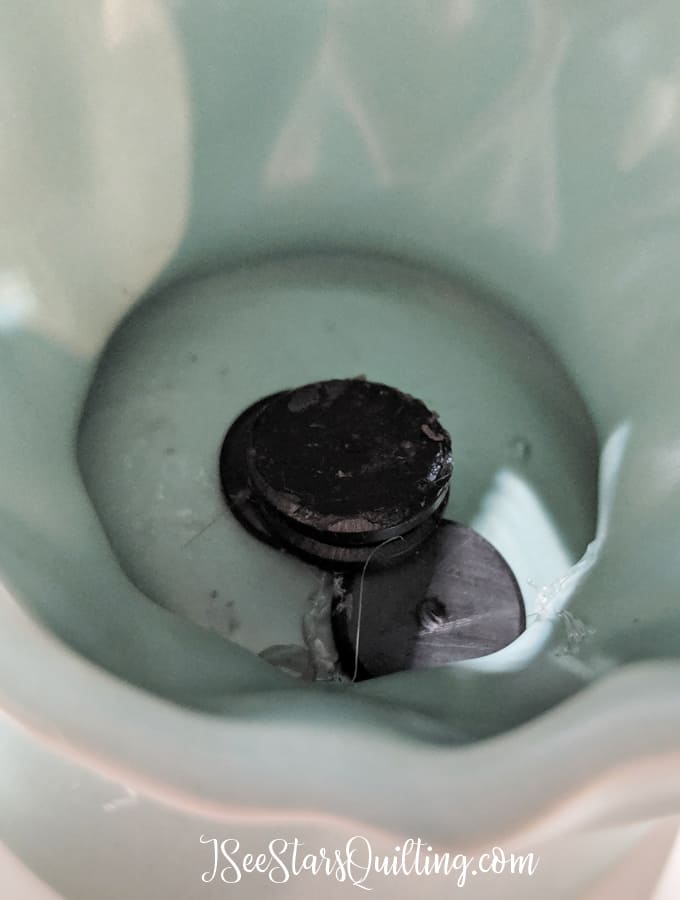
That is why today, I suggest going with the trusty craft glue gun. Instant hold. Instant gratification and no waiting for your glue to dry or making a mess (see above…)
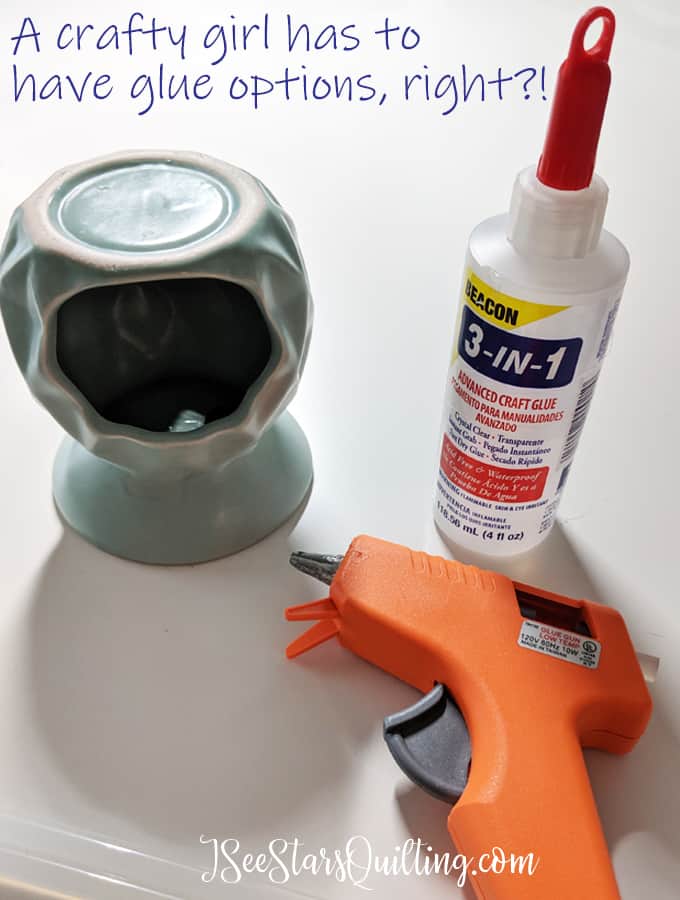
I put a nice big glob of glue on the magnet and it held really nicely on the underside of the “wax melting plate”
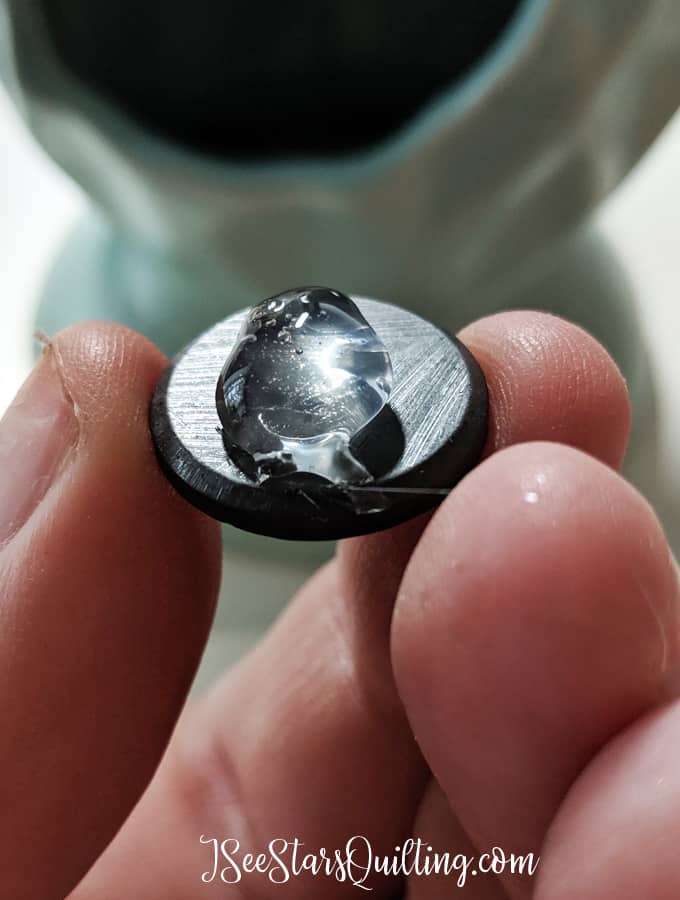
Once you glue your magnets on, flip your soon to be pineapple back over and test out the magnets with a few pins. You should have a pretty good hold.
If you aren’t the best at painting… don’t worry! I did a really sloppy job at this pineapple and it still came out looking like a pineapple. I’m just going with “abstract pineapple”… and it’s art! Therefore, it is beautiful.
You also could get out a can of gold spray paint or glitter paint or whatever makes your heart happy and make it completely your own. 🙂
I do enjoy painting. See my 2 favorite mugs? Yes, these must BOTH be used when I paint and one of them usually has water or wine, depending on the time of day.
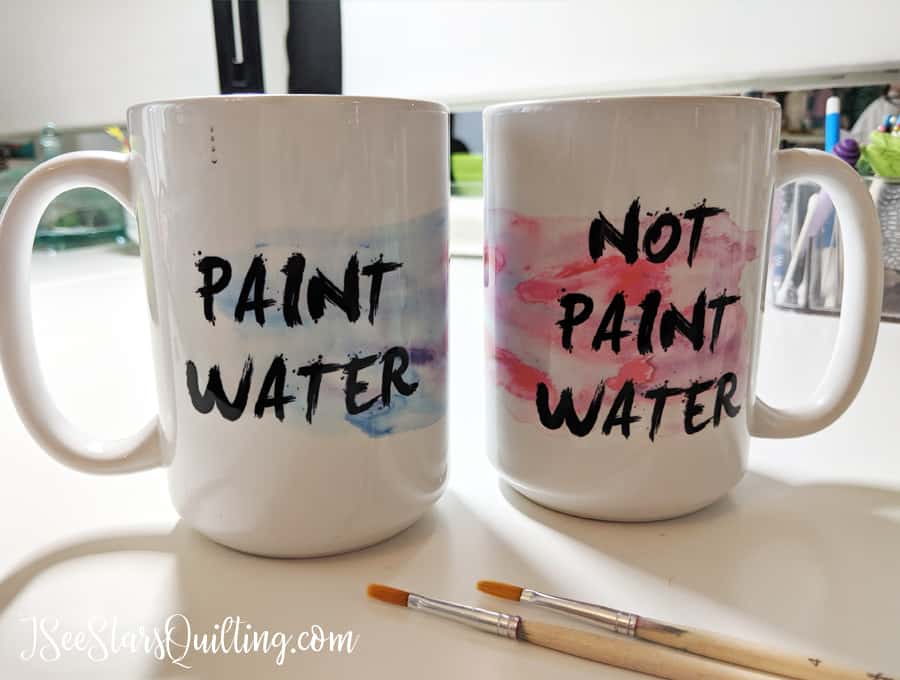
I started painting the greens in the pineapple first. Most of it will be covered up by yellows and eventually browns so you don’t have to be too neat with your painting.
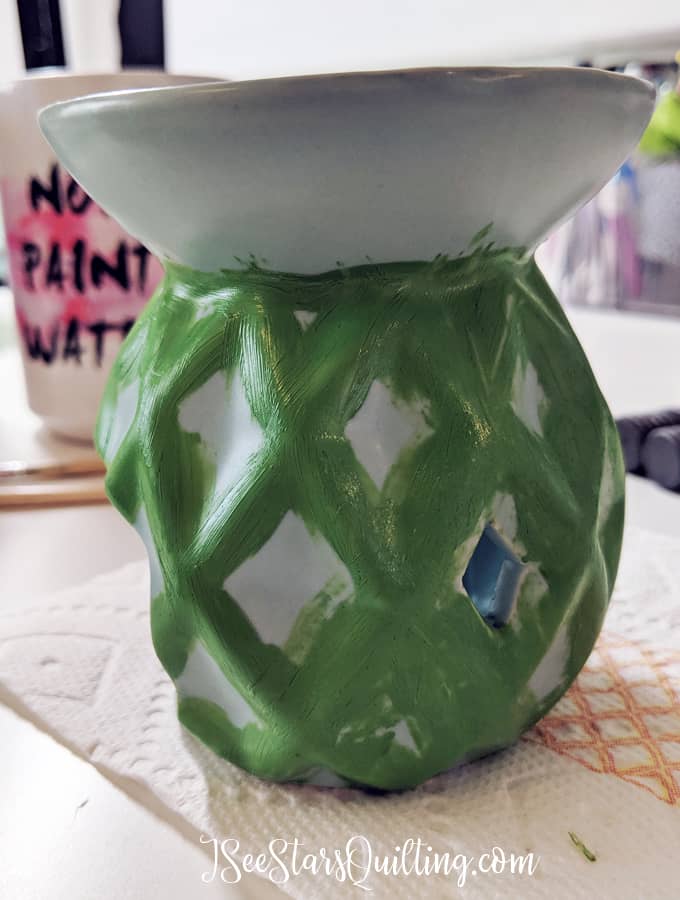
Then I added 2 different colors of yellow, white, brown and a slightly darker green strokes for a little more demention.
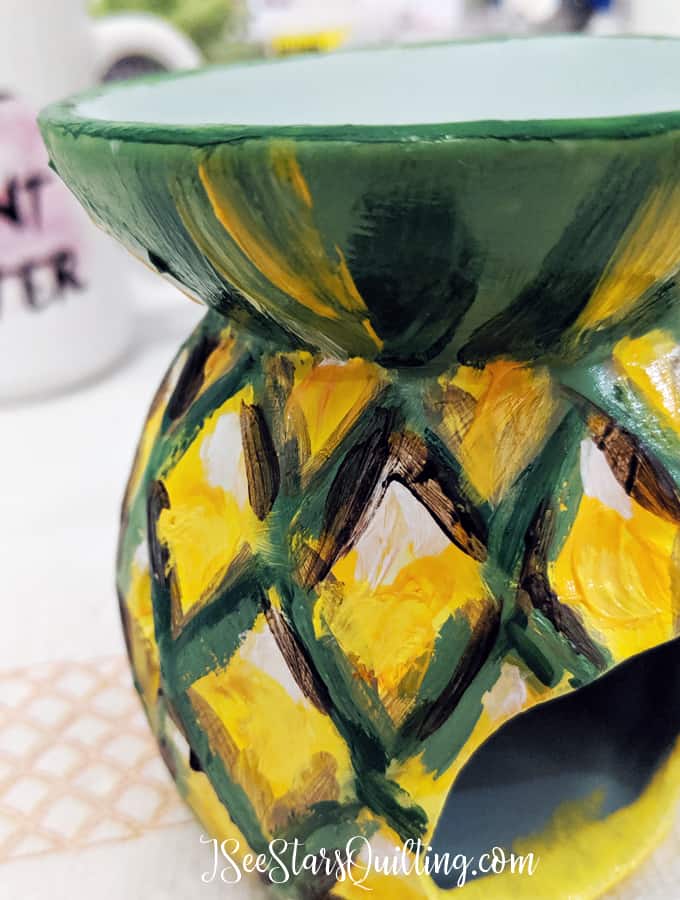
Let all your paint dry well before proceeding to the next step.
I used a small scrap of yellow fabric that I dug out of my scrap pile. I really like the criss-cross lines that echo the pineapple theme.
For the filling, I used some polyester batting scraps simply because that is what I found first. You can fill your pineapple with other fabric scraps or steel wool or whatever you have on hand.
Test measure your pincushion to find the right amount of filling to put in. Check the firmness when you insert a pin. If it is too soft, add more stuffing/filling. You’ll want to make sure your pin cushion area is tough enough to hold a good number of pins.
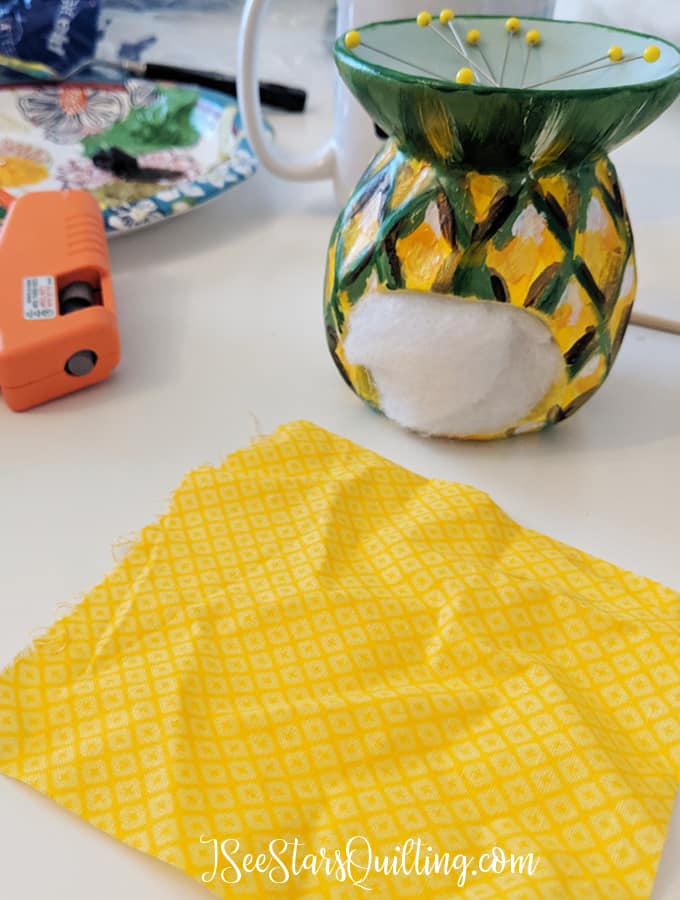
Wrap your chosen fabric around the inside stuffing or batting and tuck in all the edges inside your pineapple.
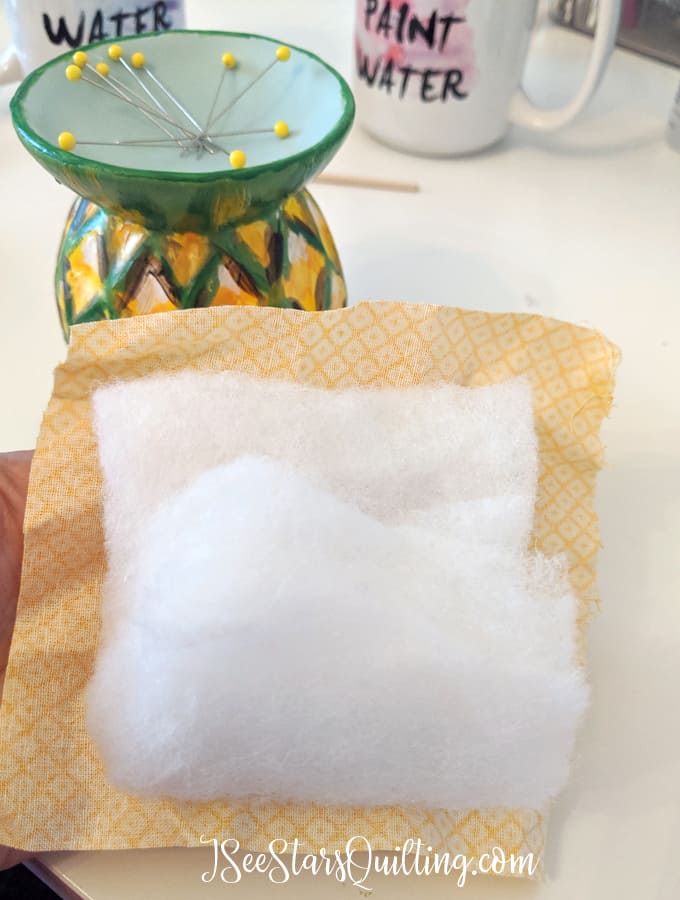
I did like the smooth flat surface that the batting gave when I stuffed it in the pineapple.
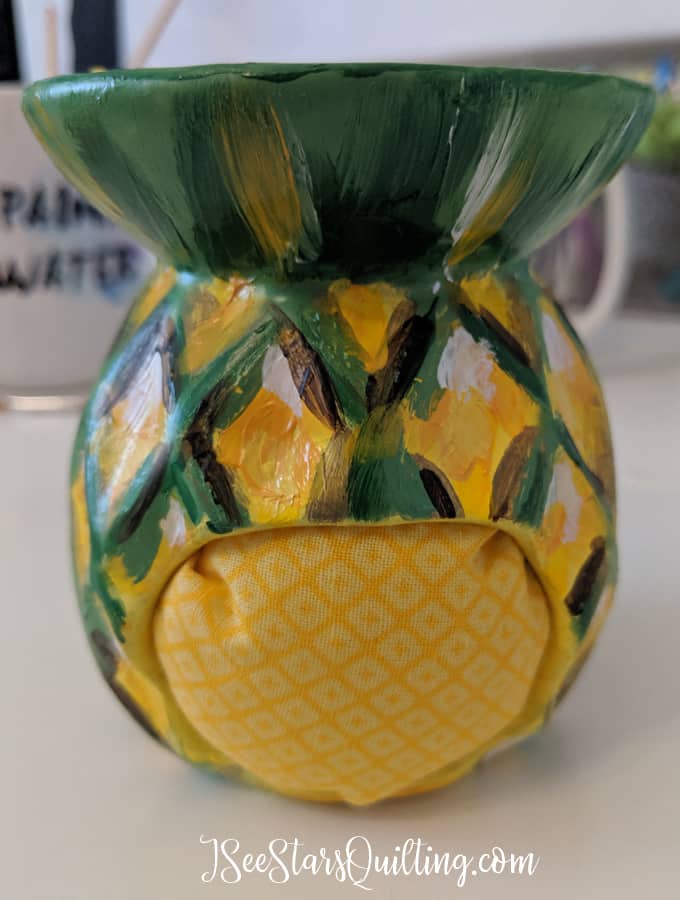
To complete the project, I didn’t find that any glue was really necessary. I just tucked in the raw edges of the fabric and called it done. You’ll have to be the judge on this part for yourself. Glue certainly isn’t going to hurt anything if you like it to be a little more secure. 🙂
Enjoy your DIY Pineapple Pincushion! If you decide to DIY this project, let me know in the comments down below.
Happy Crafting!
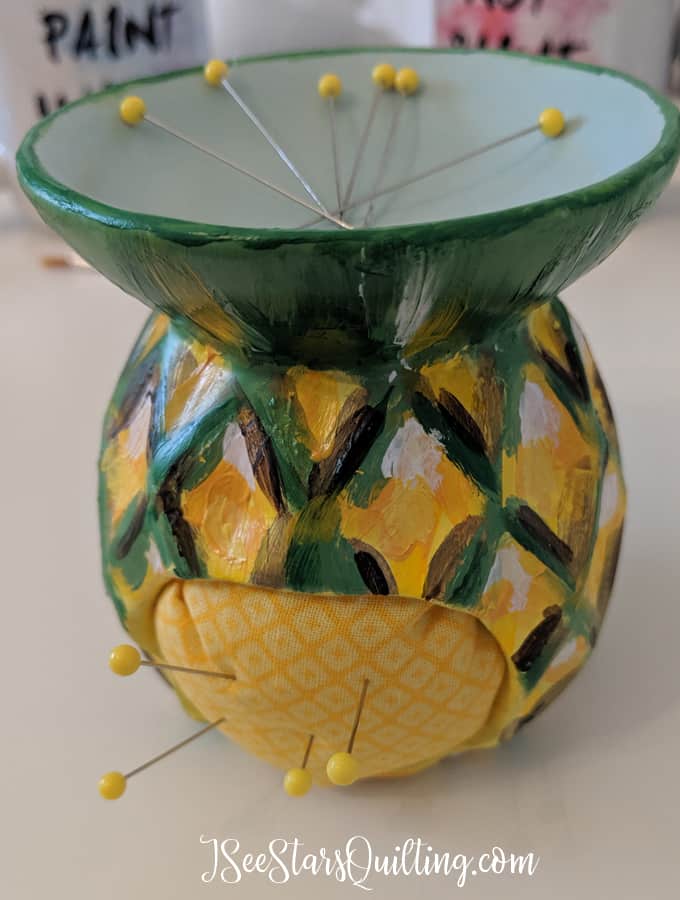
Hey hey! There is nothing like the day that you decide that you’re ready to upgrade your sewing machine… You might be a little sad to see your current machine go, but that doesn’t mean that you can be super excited for all that your new machine can do for you! Today I am going to share with you the best sewing machine deals on Amazon!
I don’t think I’ve made any attempt to make it a secret that I absolutely LOVE Amazon. I will shout it from the rooftop if you like because I really do love it.
It is a busy mom’s sanity saver. And if you aren’t a Prime member, I highly suggest looking into it because um hello? Free shipping! Woohoo!
But I digress… because that is a topic for another coffee date between us And that is not what we’re here to talk about today!
The reason I highly recommend Amazon for starting your new sewing machine shopping is simple… Do it for the reviews! thousands of people just like you, not experts, freely giving their opinions and sharing their grievances openly for you to read.
For example, this is the sewing machine that I use: The Janome 3160QDC
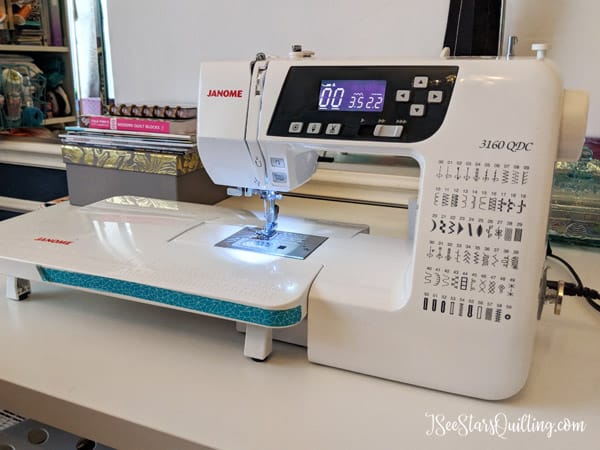
It has a rating of 4.7 stars out of 5. That is a pretty high rating. (and that price is a steal if you were wondering…)
People love my machine because it is super easy to use and the instruction manual is really simple to understand. I’ve never had one issue that couldn’t be solved in a matter of about 10 minutes.
Also, it sews beautifully and quilts like a dream 😉 I may be a little biased but I’ve never sewn on anything I loved more than my own Janome machine. *honest*
Let’s look at some more really great deals!
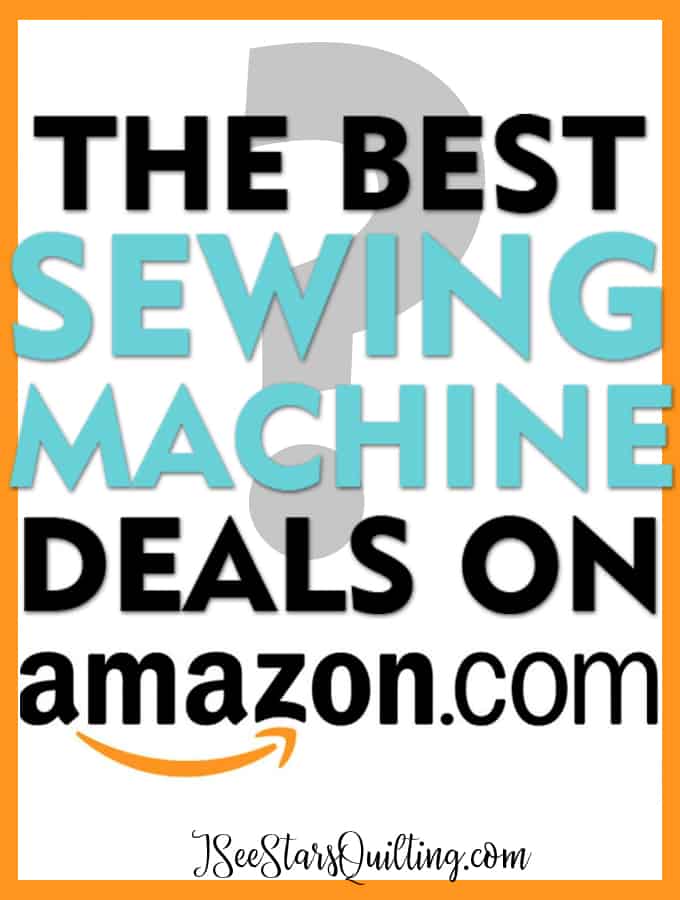
Here is a link to all of the machines that fit these parameters, but I’m going to share my favorite choices below!
These machines are great for beginners just dipping their toes into quilting with the big kids. I like that they come with everything that you need to get started including the extension table. For this price/level, you’re looking at a machine that can handle quilting through layers of fabric and even a few decorative stitches too. Also, these machines are simple to understand and work with.
These machines are a little more money upfront, but will allow you further options in exploring more complicated and challenging quilting as you progress.
I really love my model Janome and feel that it is a wonderful machine, but I put it in this category because it isn’t their newest model and therefore it is lower in price 😉 yay!
My advice on leaning on other people’s opinions is this, however… Some people’s opinions should be taken with a grain of salt because some people will never be 100% happy. – no matter how many jewels they hold! – just my two cents!
If you are looking for specific answers to questions you have… no amount of internet searching in the world can replace the knowledge and advice of a sewing machine repair shop!
These talented men and women have seen the insides of thousands of machines and can tell you what they see the most, what their preference is on lasting machines and may even have a few used machines in house that they can sell to you at a good price.
You never know until you ask!
Good luck machine shopping. I’m so excited for you… even if you’re only thinking about looking at a new machine, it is still a super exciting possibility on the horizon for you with lots of creative adventures to come!
Happy Sewing!
Tell me in the comments below what your favorite sewing machine purchase has been?
Whether you just purchased a brand new sewing machine or you’ve had yours for a while, eventually the question is bound to come up… “How much does it cost to get my sewing machine serviced?” and “Do I need it? How often should I go?”
The recommended answer is that you should take your machine in about once a year to have it serviced. However, my experience is that you can go a little longer to stretch those services out a little bit more.
With good in between care done by YOU, using some of the tips I’ve outlined below… you can stretch it into about every 2 years as long as everything is running smoothly.
Obviously if you notice something is off or there is a weird noise that you didn’t notice before… PLEASE take your machine to have a good once-over by a professional shop.
A lot of quilter and sew-ists like to think of it as a luxury spa day for their machines! ooh-la-la!
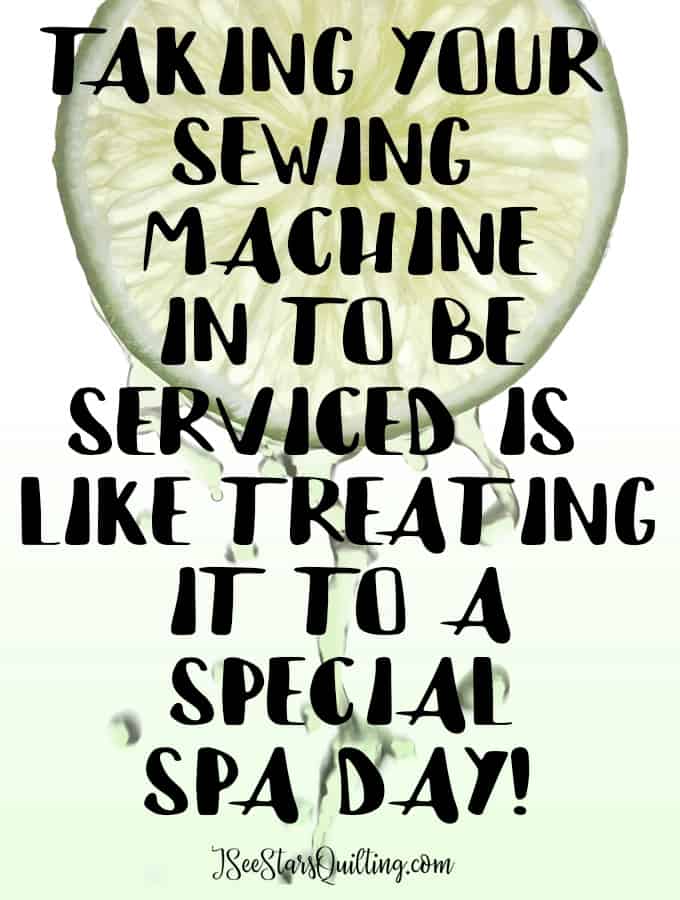
A sewing machine tune-up costs can vary according to each shop, but general cost ranges are in the $75 to $100 Range. These charges will not include the cost of any broken or replacement parts.
Computerized embroidery machines may cost as much as $100 for basic repairs.
Before you put away your wallet and decide to just start saving up for your next sewing machine… we’re going to go over exactly what a sewing machine service entails, why your machine needs it (no, its not a hoax) and if you can save the money and perform the service yourself… AND a few little things you can do throughout the year to stretch your money a little further!
There are many many many moving parts to a sewing machine.
If it moves, it needs lubrication to avoid wear and tear.
As a sewing machine is used, the lubrication eventually dries out. Once it has dried out, moving parts don’t work as well. The well being of the sewing machine starts to wear out faster than if it was maintained on a regular basis.
Most new sewing machines are making the move toward higher-tech machinery. Your machine may have a computer circuit board and wires inside as well. Sewing machine technicians are specially trained to maintain and service computerized sewing machines. Unless you know exactly what you are doing, it isn’t recommended to ‘go inside’ and do anything yourself. A circuit board can easily fry at the hands of a well-meaning but clueless soul.
A yearly service will prevent any heavily worn areas to be caught before they cause a worse problem down the road.
Most machines do not need major replacement of parts when preventative maintenance is scheduled.
Case in point: You machine should be serviced to keep it running smoothly for a long long time.
Just like our bodies, teeth and car receive yearly check-ups, make sure your sewing machine receives equal treatment!
The short answer? A WHOLE LOT!
A full service isn’t just a quick in and out. Technicians will have a long checklist of items to carefully go over as they take a look at your machine.
Here is an example of the checklist performed during a routine service:
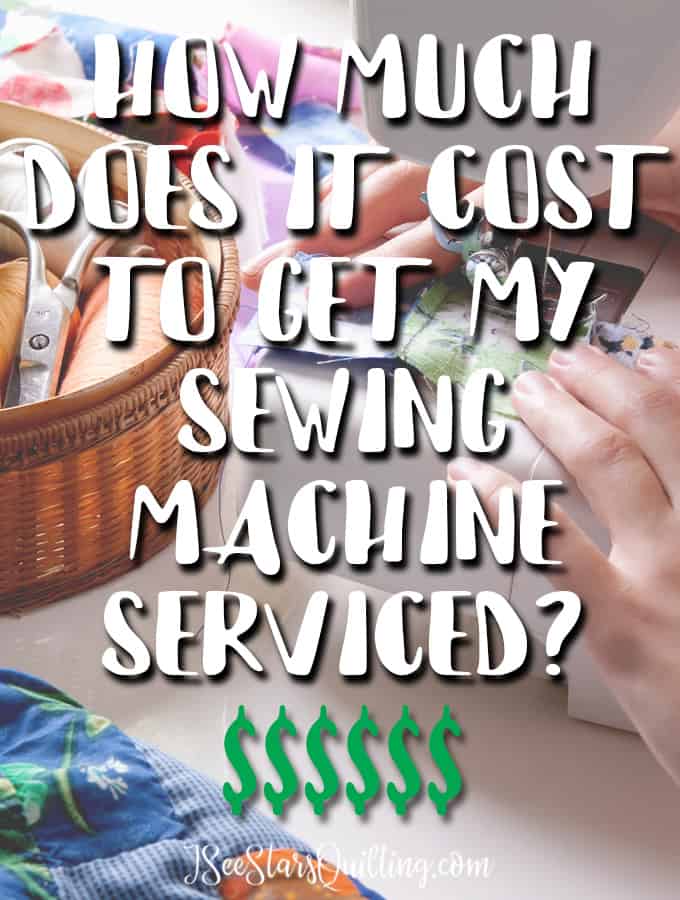
This list is pretty simple and straight forward. You’ll want to bring:
You shouldn’t only take care of your machine once a year, however… careful care should be considered every single time you sew.
I take my machines once every 2 years. Another quilter may tell you a different amount of time. You just have to find the comfortable medium between how your machine is acting and what your wallet can handle.
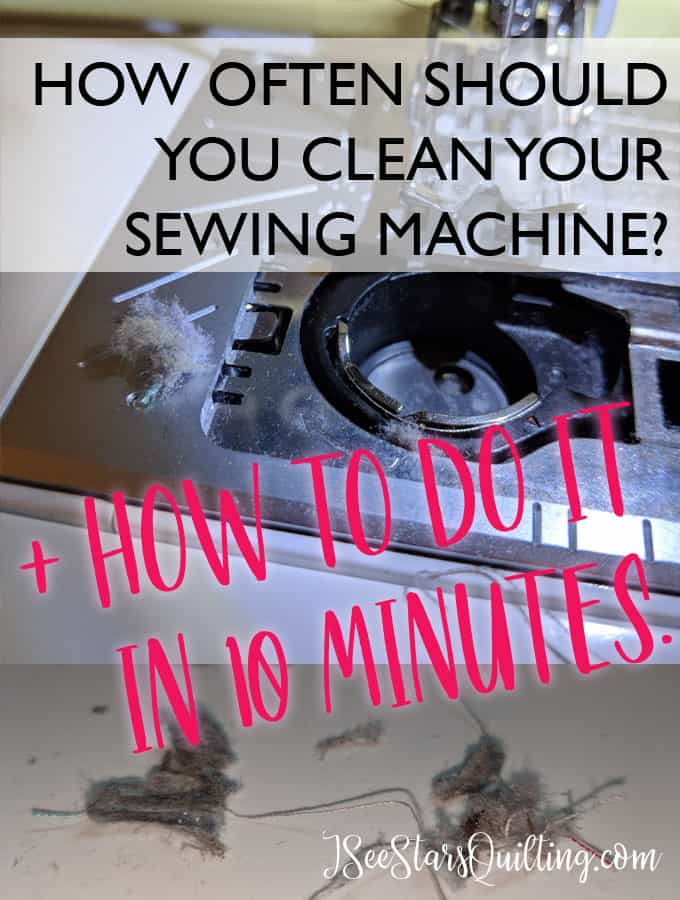
There are a lot of videos on YouTube that instructs you how to service your own machine. I recommend giving them a good look before you just open up your machine and taking things apart…
Personally, I very much suggest doing as much of the maintenance yourself on your machine as possible. This can stretch the time in between your services and make sure that things are running smoothly in between. You can read more about cleaning your machine in this post.
If you use your sewing machine to sew (duh…)… you MUST clean it!
Fabrics are linty, some threads are linty and that all leads to moving parts moving not so freely. Uncleaned machines lead directly to skipped stitches, uneven stitches, and broken threads right in the middle of a seam.
It is an awful mess to be in when you’re nearing the end of a project and have to stop!
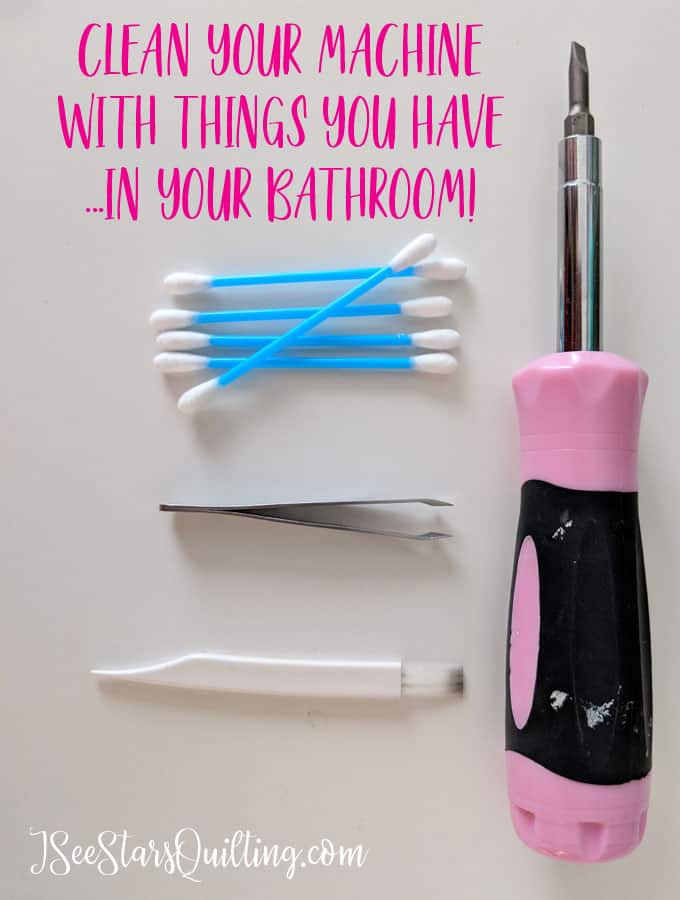
You might think that a little sewing here or there won’t leave much of a mess inside your machine, but you would be completely wrong!
Soft minky fabric is the worst for causing all kinds of lint buildup after just a few minutes of sewing.
After each project that you sew, take a few minutes to open up your machine and empty out the lint and any thread fuzz. You’ll thank me later 😉
The best thing to do is to call around and find a place that does not have to ship/take your machine off-sit to be serviced.
Most vacuum and sewing machine stores will have technicians on site to work on your machine.
If a shop sends your machine off to be serviced, you will be looking at a longer turn around time.
You can also call your local small business quilting shop and see where they recommend or where they take their own machines. Big box stores will not be able to send you anywhere.
Make sure that the terms are very clear when you drop off your machine.
Whew! I know that was a lot to digest but hopefully, you’ve learned a thing or two and I have completely answered your question, “How much does it cost to get my sewing machine serviced?”… and then some because I’m totally about providing the extra information that you need to know!
How much does it cost to have your machine serviced where you live?
Are you ready to have the ultimate sewing space?
I shared pictures and all the details on my office/sewing space and it got me thinking about what exactly was essential for it to function well.
Like, if I were to help someone else set up their perfect sewing space, what would you HAVE to have?
Today I’ve got a few tips for you on how to set up your own ultimate sewing space —plus a handy checklist for ensuring you don’t miss anything!
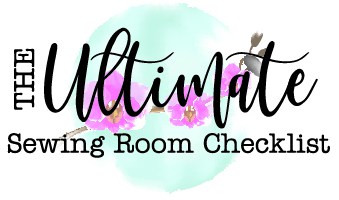
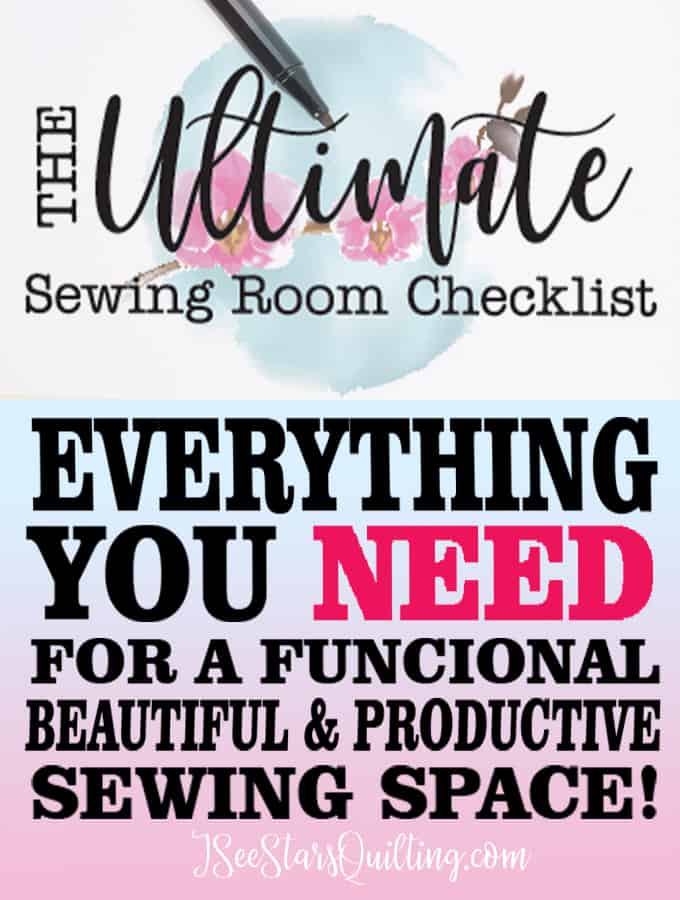
Chances are that you already might have several things around your home that would be useful to use for your sewing space. There is no need to go out and buy a ton of storage or big furniture until you actually know what it is you’ll be storing!
Take some time going through your home and bring out all of the sewing supplies and gadgets and gizmos-a-plenty. all the whos-its and whats-its galore. Pull them all into one place and categorize like things together in piles.
Once you know what you have, you’ll be able to better categorize it and take note of anything you need, but don’t have or have but don’t need.
After you’ve taken mental note of what you already have, I want you to pause and think about what you *need*. Yes… we can all flirt with the boundaries of being a full on hoarder. You don’t have to go fully minimal with your supplies, but you don’t want to have so much that you can’t find the things that you do need either.
If you have more than one of something, consider parting with it if you’re looking to de-stash.
You might be tempted to go out and get storage happy with all the cute bins and baskets and drawers, oh my! — Look out Target… we have a woman who wants to organize! I swear they can spot you from a mile away and your pocketbook might even start to shake with fear.
Even if you don’t already any have organizers or baskets, you might realize that you don’t need as much as you think you do to be really effective.
You might be one of the lucky girls with a whole spare bedroom for your sewing space or you might just have a small temporary table that you set up in the dining room from time to time.
Whatever you have, keeping your supplies organized and easily accessible is going to give you the efficiency to spend far more time creating and far less time looking for things… or even having to go to the store because you know you have it, but you can’t find what you need!
This post also has some really good ideas on improving your current sewing space.
Once you have all of your sewing supplies, you’ll want to actually organize everything to get your ultimate sewing space set up!
Hear these words… do not just put things wherever there’s a free spot or a free shelf. No! Resist, I tell you! I want you to be strategic about setting up your space.
Organize your sewing space based on your personal needs and priorities.
For example, we know that the seam ripper is going to get used… a lot. Don’t hide it at the back of a drawer that’s difficult to get at. Instead, make it easy to access! You don’t want to have to quit your creative flow just because you can’t find a basic sewing tool!
Consider what supplies you are constantly reaching for and need to easily access. Then do your best to keep them within arm’s reach. This will keep you more on-task when you’re working.
How often do you clean and tidy your creative or sewing space?
…Come on now, be truthful with yourself! You don’t have to tell me.
When was the last time you cleaned your sewing machine? (hint, you can read this post if you want to know how) or dusted all those nooks and
It’s HARD to remember to keep your sewing space neat and tidy, but it will do wonders for your productivity levels!
Creativity is messy, yall. It really is… but There is a difference in DIRTY and just slightly cluttered
Make sure it is a space that you actually WANT to work in every day!
Make your sewing room a beautiful haven that you LOVE to be in! After you finish sewing, take 60 seconds to tidy up and organize. Set yourself up for success the next time you come to sew.
Avoid distraction like your sanity depends on it
Maybe you have superior laser focusing abilities… I, do not possess those skills. I am more like a squirrel in a nut factory with ADD. Basically, try your best to hide anything in your sewing space that you aren’t working on or related to the project that you are working on. Keep your workspace clear so your brain doesn’t have a choice!
You might be wondering, “but what about my trinkets? All my lovely fabrics? Or pictures of my grandkids, or plants? They don’t have anything to do with quilting/sewing. Do I have to hide them from view in my office?” No! Things like that can stay—just LIMIT how many you have on display if you can. Limit those little extras so that your sewing space remains primarily a space for sewing and productive creativity. You can still allow some of your personal interests/joys in life to shine through.
When you do this, you’ll find that you are able to stay so much more focused on your projects at hand, and you’ll be less distracted—which means you’ll produce higher-quality work. Win-win!
Don’t be afraid to take a good hard look at your recycled boxes when it comes to organizing. Even if you look at it as a temporary fix.
Perhaps the budget doesn’t allow for a full makeover right now. You can “test out” different sizes and ideas by anticipating what you might need and give it a go before making any purchases.
You can read this post for more ideas on cheap storage solutions for your sewing room
Or you can read this post for ideas on how to store you scrap fabric.
Every person’s habits vary and what works for one sewist might not be the most efficient for another — you need to figure out what kind of organizational systems and ultimate sewing room set-up is right for you!

I love to go shopping for fabric!… (and like a lot of quilters I know…)
I love love love fabric. Don’t you just love collecting it and using it in beautiful quilts to show it
I also love a good bargain so I’ll tell you my secrets on shopping for bargain fabric too! You can also check out my tips on How I find fabric for $2 a yard!

My first go-to website is Fabric.com They have a HUUUUUGE selection of fabric in
It is a color obsessive quilter’s dream paradise because you can shop by color, fabric type, theme etc.
However, I have found that they don’t carry a lot of the smaller more limited collection prints… so if you’re looking for the super specialized fabric you may have to dig a little deeper into the internet.
How to find the deals: Shop clearance and closeout fabrics first. Then fill in with what you need from the full priced fabric.
Side Note: You can also get an extra 1% discount if you sign up for an

FatQuarterShop is a store with us quilter’s in mind! I’m talking all the bundles, jelly rolls, layer cakes, quilt patterns, notions and fabric in one beautiful store.
They offer FREE shipping if you spend over $80 – yes,
There is also a flash sale every single day that I am so tempted by every time I shop. Its 1 product every single day that is deeply discounted for 24 hours and then a new one the next day. who doesn’t love that bargain grab?
There is also these incredibly essential band-aids that no quilter should be without! And at $4.48/box… well we can heal any needle prick, can’t we?
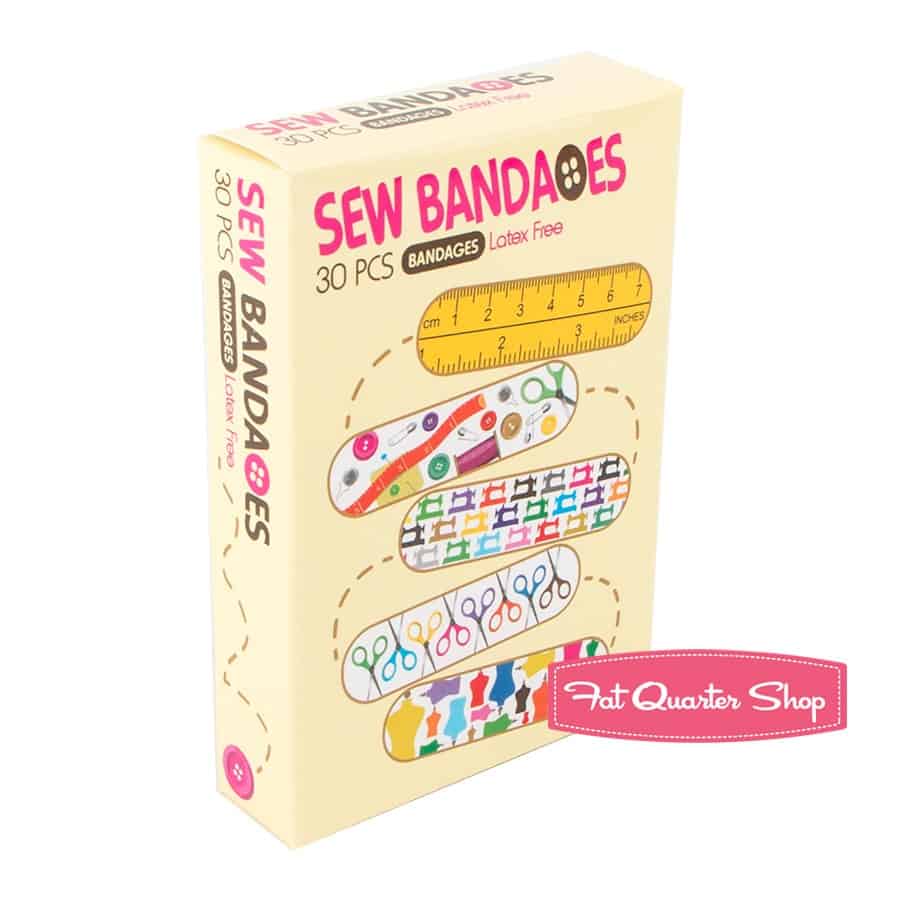
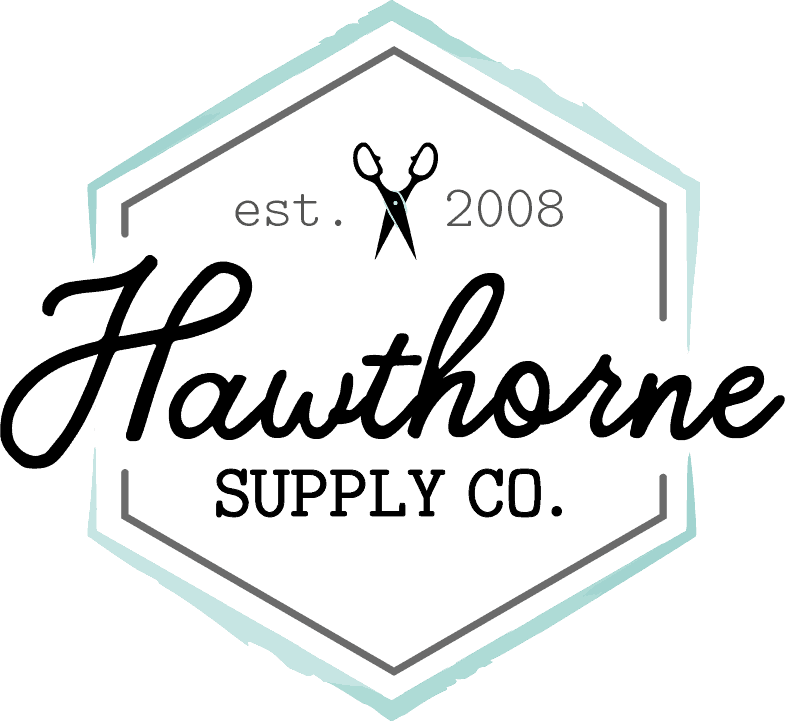
Hawthorne Supply Co has long been a favorite of mine! It is run by a husband and wife that are just adorable.
They have a good selection of sale fabrics and their site is absolutely beautiful and easy to navigate to find exactly what you are looking for quickly.
They also have great giveaways on their site frequently… I have never been fortunate enough to win one but… I must keep trying because you never know, right?

Keepsake Quilting is a wonderful site for quilting fabrics! Oh, they have a fine collection, yes they do!
They also have a great selection of notions, patterns and clearance fabrics too!

I couldn’t help it… their name drew me in bu their fabric selection brings me back again and again. Thousands of bolts
… and it is organized by color too so its easy to pull together the look you have in your mind when you are planning a quilt but don’t know exactly what you need.
They also have specials on fabrics for just over $5 a yard!

Clair’s Fabrics is a lovely (Australian) shop. It is full of such wonderful modern and contemporary prints and fabrics. I feel like I get lost in a wonderland looking through the selections!
You can even shop by designer which is a nice touch if you have your favorites and want to shop quick to see whats new!

First of all… a Pink Castle logo! duh…. second of all, really great deals on pre-cuts and bundles! Pink Castle Fabrics is a hot spot for quick and easy shopping.

Bloomerie is a super well organized online shopping experience and I have never had one single issue with my order.
I usually find several fun finds in their sale section as well

This darling website is just that… everything is just adorable and I want it all. The people who work to curate the bundles at Cottoneer are absolutely gifted in what they do. I envy their talents with all my fabric loving heart.

Fabricworm has been in the business of fabric obsessing for over 10 years now. I love their selection of Japanese Imported fabrics.

One of my last (but certainly only scratching the surface of online fabric shopping) is Connecting Threads.
First of all – free shipping on your first order when you join their email list (yay!)
Once you’re in, you can shop by color, fabric use, type etc. This makes it easy to go straight to what you’re looking for.
*Whew!* Thats was a little long winded but I hope you have found a new store or two to browse through this evening 🙂 Go shopping and enjoy the best places to buy fabric online!
There are so many fabrics out there just waiting for you to scoop them up and turn them into something wonderful!

What about you? Where are you favorite places to shop for fabric?